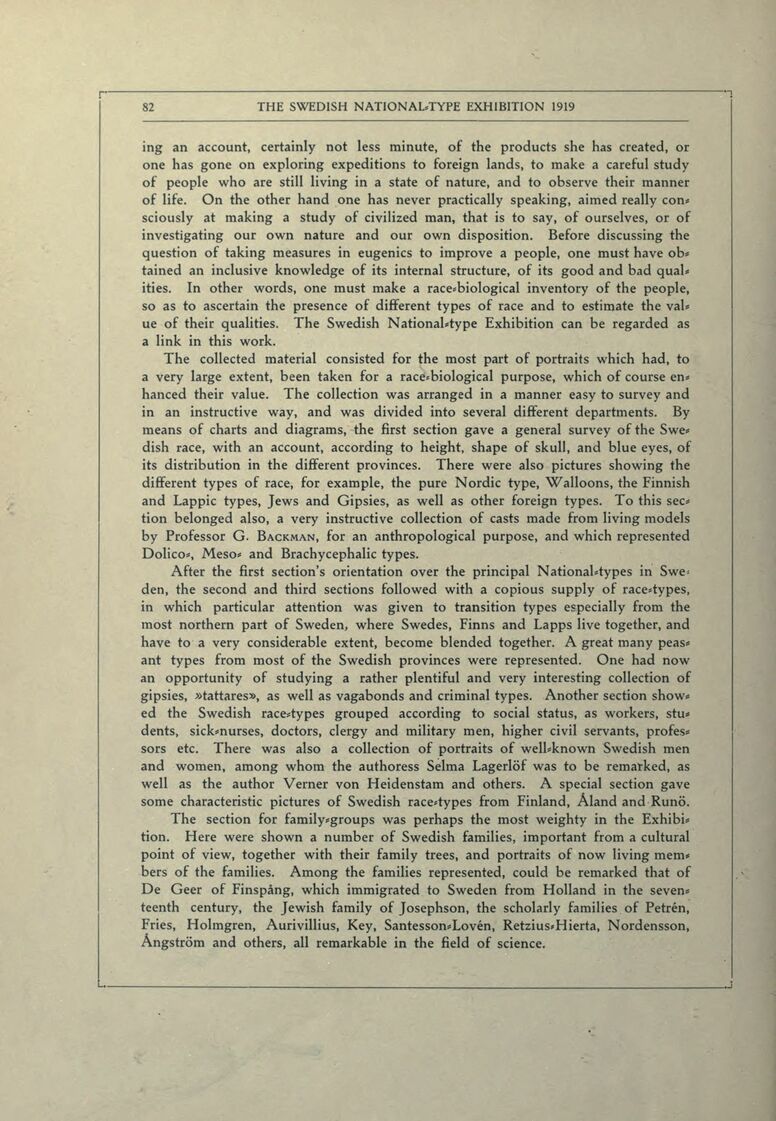
Full resolution (JPEG) - On this page / på denna sida - Part I - Doctor Emanuel Bergman, Uppsala, The Swedish National-type Exhibition 1919

<< prev. page << föreg. sida << >> nästa sida >> next page >>
Below is the raw OCR text
from the above scanned image.
Do you see an error? Proofread the page now!
Här nedan syns maskintolkade texten från faksimilbilden ovan.
Ser du något fel? Korrekturläs sidan nu!
This page has never been proofread. / Denna sida har aldrig korrekturlästs.
82 THE SWED1SH NATION AL«TYPE EXHIBITION 1919
ing an account, certainly not less minute, of the products she has created, or
one has gone on exploring expeditions to foreign lands, to make a careful study
of people who are still living in a state of nature, and to observe their manner
of life. On the other hand one has never practically speaking, aimed really con«
sciously at making a study of civilized man, that is to say, of ourselves, or of
investigating our own nature and our own disposition. Before discussing the
question of taking measures in eugenics to improve a people, one must have ob«
tained an inclusive knowledge of its internal structure, of its good and bad qual«
ities. In other words, one must make a race«biological inventory of the people,
so as to ascertain the presence of different types of race and to estimate the val«
ue of their qualities. The Swedish Nationabtype Exhibition can be regarded as
a link in this work.
The collected material consisted for the most part of portraits which had, to
a very large extent, been taken for a race«biological purpose, which of course en«
hanced their value. The collection was arranged in a manner easy to survey and
in an instructive way, and was divided into several different departments. By
means of charts and diagrams, the first section gave a general survey of the Swe«
dish race, with an account, according to height, shape of skull, and blue eyes, of
its distribution in the different provinces. There were also pictures showing the
different types of race, for example, the pure Nordic type, Walloons, the Finnish
and Lappic types, Jews and Gipsies, as well as other foreign types. To this sec«
tion belonged also, a very instructive collection of casts made from living models
by Professor G. Backman, for an anthropological purpose, and which represented
Dolico«, Meso« and Brachycephalic types.
After the first section’s orientation over the principal Nationabtypes in Swe*
den, the second and third sections followed with a copious supply of race«types,
in which particular attention was given to transition types especially from the
most northern part of Sweden, where Swedes, Finns and Lapps live together, and
have to a very considerable extent, become blended together. A great many peas«
ant types from most of the Swedish provinces were represented. One had now
an opportunity of studying a rather plentiful and very interesting collection of
gipsies, »tattares», as well as vagabonds and criminal types. Another section show«
ed the Swedish race«types grouped according to social status, as workers, stu«
dents, sick«nurses, doctors, clergy and military men, higher civil servants, profes«
sors etc. There was also a collection of portraits of welbknown Swedish men
and women, among whom the authoress Selma Lagerlöf was to be rematked, as
well as the author Verner von Heidenstam and others. A special section gave
some characteristic pictures of Swedish race«types from Finland, Åland and Runö.
The section for family«groups was perhaps the most weighty in the Exhibi«
tion. Here were shown a number of Swedish families, important from a cultural
point of view, together with their family trees, and portraits of now living mem«
bers of the families. Among the families represented, could be remarked that of
De Geer of Finspång, which immigrated to Sweden from Holland in the seven«
teenth century, the Jewish family of Josephson, the scholarly families of Petrén,
Fries, Holmgren, Aurivillius, Key, Santesson«Lovén, Retzius»Hierta, Nordensson,
Ångström and others, all remarkable in the field of science.
<< prev. page << föreg. sida << >> nästa sida >> next page >>